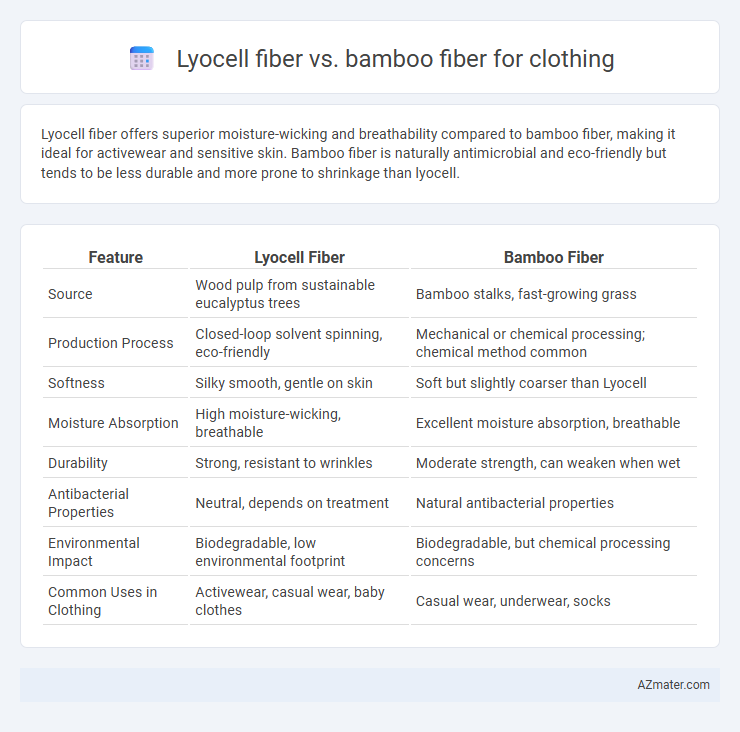Lyocell fiber offers superior moisture-wicking and breathability compared to bamboo fiber, making it ideal for activewear and sensitive skin. Bamboo fiber is naturally antimicrobial and eco-friendly but tends to be less durable and more prone to shrinkage than lyocell.
Table of Comparison
| Feature | Lyocell Fiber | Bamboo Fiber |
|---|---|---|
| Source | Wood pulp from sustainable eucalyptus trees | Bamboo stalks, fast-growing grass |
| Production Process | Closed-loop solvent spinning, eco-friendly | Mechanical or chemical processing; chemical method common |
| Softness | Silky smooth, gentle on skin | Soft but slightly coarser than Lyocell |
| Moisture Absorption | High moisture-wicking, breathable | Excellent moisture absorption, breathable |
| Durability | Strong, resistant to wrinkles | Moderate strength, can weaken when wet |
| Antibacterial Properties | Neutral, depends on treatment | Natural antibacterial properties |
| Environmental Impact | Biodegradable, low environmental footprint | Biodegradable, but chemical processing concerns |
| Common Uses in Clothing | Activewear, casual wear, baby clothes | Casual wear, underwear, socks |
Introduction to Lyocell and Bamboo Fibers
Lyocell fiber is a sustainable, eco-friendly material derived from wood pulp, known for its softness, breathability, and moisture-wicking properties, making it ideal for comfortable clothing. Bamboo fiber, extracted from bamboo grass, offers natural antibacterial qualities, exceptional breathability, and biodegradability, appealing to environmentally conscious consumers. Both fibers provide biodegradable, renewable alternatives to traditional fabrics, with Lyocell often praised for its production process and Bamboo for its antibacterial benefits.
Raw Material Sources and Sustainability
Lyocell fiber is derived from sustainably managed eucalyptus forests using a closed-loop production process that recycles water and solvents, minimizing environmental impact. Bamboo fiber, sourced from fast-growing bamboo plants, requires less water and pesticides but often involves chemical-intensive processing methods unless mechanically produced. Both fibers offer eco-friendly alternatives to conventional fabrics, with Lyocell emphasizing advanced sustainable manufacturing and bamboo highlighting renewable raw material advantages.
Manufacturing Processes Compared
Lyocell fiber is produced using a closed-loop process that dissolves wood pulp with non-toxic solvents, enabling efficient recycling of chemicals and minimal environmental impact. Bamboo fiber manufacturing typically involves chemical-intensive methods like viscose processing, which use harsh chemicals and generate more pollutants. The Lyocell manufacturing process offers superior sustainability and eco-friendliness compared to the chemical-heavy production of bamboo fiber.
Environmental Impact: Lyocell vs Bamboo
Lyocell fiber is produced through a closed-loop process that recycles water and solvents, significantly reducing environmental pollution compared to traditional textile manufacturing. Bamboo fiber often involves chemical-intensive processes that can release toxins unless mechanically processed, making its sustainability variable depending on production methods. Lyocell's certified eco-friendly production standards typically result in a lower carbon footprint and less habitat destruction than mass-produced bamboo fibers.
Texture and Feel on Skin
Lyocell fiber offers a smooth, silky texture that feels soft and breathable against the skin, making it ideal for sensitive skin and providing excellent moisture-wicking properties. Bamboo fiber boasts a naturally soft, silky feel with a slightly more textured surface, known for its antibacterial qualities and enhanced breathability that keeps the skin cool and dry. Both fibers excel in comfort, but Lyocell tends to have a more uniform texture, while bamboo provides a naturally plush feel with added antimicrobial benefits.
Moisture-Wicking and Breathability
Lyocell fiber offers superior moisture-wicking capabilities due to its high absorbency and smooth surface, allowing quick perspiration evaporation and enhanced breathability in clothing. Bamboo fiber also provides good breathability and natural antimicrobial properties, but its moisture-wicking performance is generally less efficient than Lyocell. For activewear and garments requiring rapid drying, Lyocell outperforms bamboo in maintaining comfort and freshness during extended wear.
Durability and Longevity
Lyocell fiber exhibits superior durability compared to bamboo fiber due to its stronger molecular structure and resistance to wear, making it ideal for long-lasting clothing. Bamboo fiber tends to break down faster under repeated washing and exposure to sunlight, reducing garment lifespan. The moisture-wicking and breathable properties of lyocell maintain fabric integrity over time, enhancing overall longevity in apparel applications.
Hypoallergenic Properties
Lyocell fiber, derived from sustainably sourced wood pulp, offers superior hypoallergenic properties due to its smooth, non-irritating surface and moisture-wicking capabilities that reduce bacterial growth. Bamboo fiber also demonstrates hypoallergenic benefits, as it contains natural antimicrobial agents and is breathable, but it may retain more impurities depending on processing methods. For sensitive skin, Lyocell's controlled manufacturing process and fewer residual chemicals make it a preferred choice over bamboo fiber in hypoallergenic clothing options.
Cost and Market Availability
Lyocell fiber, derived from wood pulp using a closed-loop process, typically costs more than bamboo fiber due to its environmentally friendly production and higher durability, making it favored in premium clothing markets. Bamboo fiber, often cheaper and more widely available, is popular in budget-friendly apparel but varies in quality based on manufacturing methods, sometimes involving less sustainable chemical treatments. Market availability places bamboo fiber as more accessible globally, while Lyocell's demand grows steadily within eco-conscious fashion brands targeting higher-end consumers.
Which Fiber is Better for Clothing?
Lyocell fiber offers higher moisture-wicking properties and durability compared to bamboo fiber, making it more suitable for activewear and long-lasting garments. Bamboo fiber is naturally antibacterial and softer, providing enhanced comfort and odor resistance, ideal for sensitive skin and casual clothing. When choosing between Lyocell and bamboo, consider Lyocell for performance and longevity, while bamboo excels in softness and eco-friendly appeal.

Infographic: Lyocell fiber vs Bamboo fiber for Clothing
 azmater.com
azmater.com